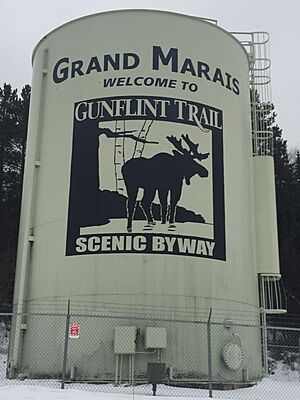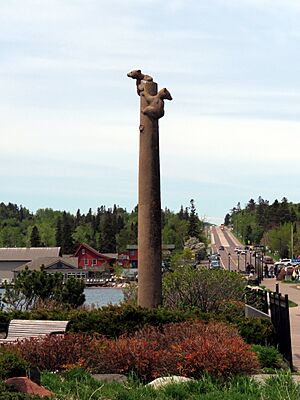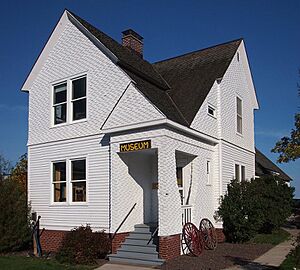Grand Marais, Minnesota facts for kids
Quick facts for kids
Grand Marais
|
|
|---|---|
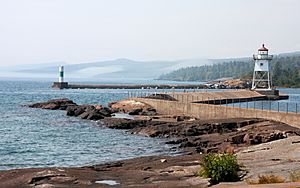
Lake Superior harbor in downtown Grand Marais
|
|
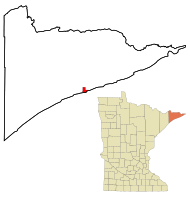
Location of the city of Grand Marais
within Cook County, Minnesota |
|
| Country | United States |
| State | Minnesota |
| County | Cook |
| Area | |
| • Total | 2.91 sq mi (7.53 km2) |
| • Land | 2.91 sq mi (7.53 km2) |
| • Water | 0.00 sq mi (0.00 km2) |
| Elevation | 617 ft (188 m) |
| Population
(2020)
|
|
| • Total | 1,337 |
| • Estimate
(2021)
|
1,340 |
| • Density | 459.61/sq mi (177.46/km2) |
| Time zone | UTC-6 (CST) |
| • Summer (DST) | UTC-5 (CDT) |
| ZIP code |
55604
|
| Area code(s) | 218 |
| FIPS code | 27-24992 |
| GNIS feature ID | 0656425 |
Grand Marais (pronounced mə-RAY) is a city in Minnesota, United States. It is the main town and county seat of Cook County. Grand Marais is located on the North Shore of Lake Superior. In 2020, about 1,337 people lived there.
Before it was settled by French Canadians, the area was home to the Ojibwe people. The Gunflint Trail, a special scenic road, starts in Grand Marais. It goes all the way to the border with Ontario, Canada.
Contents
History of Grand Marais
The Ojibwe people called this area Gichi-biitoobiig. This name means "great duplicate water" or "parallel body of water." It describes the two bays that form the large harbor on Lake Superior.
Early Fur Trading and Naming
In the 1700s, Grand Marais was a busy place for fur trading. French Canadian Voyageurs (travelers) gave the village its name, "Grand Marais." This means "Great Marsh" or "sheltered water area." The harbor has natural rock formations that protect it. This made it a safe place for early explorers on Lake Superior.
Arts and Education
Today, Grand Marais is home to several non-profit schools. These include the Grand Marais Art Colony and the North House Folk School. Many art galleries in the area show work from local artists.
Recent Events
On April 13, 2020, a big fire happened in downtown Grand Marais. It destroyed three buildings. The fire burned for over three hours because of strong winds.
Geography of Grand Marais
Grand Marais is located on the northwestern shore of Lake Superior. The city covers about 2.90 square miles (7.53 square kilometers) of land. It is a popular starting point for exploring the Boundary Waters Canoe Area Wilderness. This wilderness area is at the beginning of the Gunflint Trail. The Superior Hiking Trail also passes near Grand Marais. Judge C. R. Magney State Park is close by too.
Natural Features
The land around Grand Marais rises to form the Sawtooth Bluff. This is a dramatic rock face that you can see from almost anywhere in the city. Next to the bluff is Pincushion Mountain. This is a large, bare rock hill with amazing views of Lake Superior. You can also see the wilderness inland from here.
Grand Marais Harbor is protected by Artist's Point. This is a special landform called a tombolo. It was formed by lava and connected to the mainland by sand and gravel. A unique group of plants and animals, called an Arctic–alpine disjunct community, lives there.
Travel and Location
You can reach Grand Marais by Minnesota State Highway 61. This road follows the shore of Lake Superior and is known as the North Shore Scenic Drive. The Gunflint Trail (Cook County Road 12) also starts in Grand Marais. It heads northwest, away from the lake, into the Boundary Waters region.
Grand Marais is about 110 miles (177 km) northeast of Duluth. It is also about 38 miles (61 km) southwest of the border with Canada.
Climate in Grand Marais
Grand Marais has a climate with warm summers. This is similar to the rest of northern Minnesota. However, Lake Superior has a special effect on the weather. It makes summer temperatures cooler and winter temperatures warmer. This means the difference between seasons is smaller than in places farther inland.
For example, Grand Marais has the coolest summer temperatures in Minnesota. The average high in July and August is just below 70°F (21°C). The difference between the warmest and coldest months is only about 47.6°F (26.4°C). This is much smaller than in Tower, Minnesota, which is about 90 miles (145 km) west.
Even though it's far north, Grand Marais is in a similar plant hardiness zone as Duluth and Minneapolis. This means certain plants can grow there. The average lowest temperature in a year is about -23°F (-31°C).
Sometimes, hot temperatures can still reach Grand Marais, especially when winds come from the south. The hottest temperature ever recorded was 100°F (38°C) in July 1930. The coldest temperature recorded was -35°F (-37°C) in 1934.
Population of Grand Marais
| Historical population | |||
|---|---|---|---|
| Census | Pop. | %± | |
| 1910 | 355 | — | |
| 1920 | 443 | 24.8% | |
| 1930 | 618 | 39.5% | |
| 1940 | 855 | 38.3% | |
| 1950 | 1,078 | 26.1% | |
| 1960 | 1,301 | 20.7% | |
| 1970 | 1,301 | 0.0% | |
| 1980 | 1,289 | −0.9% | |
| 1990 | 1,171 | −9.2% | |
| 2000 | 1,353 | 15.5% | |
| 2010 | 1,351 | −0.1% | |
| 2020 | 1,337 | −1.0% | |
| 2021 (est.) | 1,340 | −0.8% | |
| U.S. Decennial Census 2020 Census |
|||
2010 Census Information
In 2010, the city of Grand Marais had 1,351 people living in 673 households. About 21.5% of these households had children under 18. The average household had 1.94 people.
The average age of people in the city was 48.4 years. About 18.1% of residents were under 18 years old. Most residents were white (93.4%). The population was 45.9% male and 54.1% female.
Arts and Culture in Grand Marais
Tourism is a big part of Grand Marais' economy. This is because of the nice summer weather and the snow in winter. The city hosts many fun festivals throughout the year. These events celebrate the history and culture of the North Shore.
Popular Festivals
- Fisherman's Picnic: This festival happens on the first weekend of August. It started when the area's economy was based on fishing and logging. People would gather for a picnic with fresh Lake Superior herring. Today, you can still enjoy fishburgers made by the Lions Club. The festival also has fireworks, contests, and a parade.
- Moose Madness: Held on the third weekend in October, this event celebrates the area's moose. It's a family-friendly event with games, prizes, and activities.
- Grand Marais Arts Festival: This long-running event takes place in early July. It features over 70 local and regional artists, live music, and art demonstrations. The Grand Marais Art Colony hosts it.
- Summer and Winter Solstice Festivals: These festivals are hosted by the North House Folk School.
- Le Grand Du Nord: This gravel bike race happens on Memorial Day weekend. It starts near the harbor and climbs to amazing views of the U.S./Canada border.
- Lake Superior Storm Fest: This festival celebrates the stormy season on Lake Superior, especially the strong winds of November.
Historic Buildings
The downtown area has two buildings listed on the National Register of Historic Places. These are important historical sites:
- The 1896 Lightkeeper's House: This building is now home to the Cook County History Museum.
- The Bally Blacksmith Shop: Built in 1911, this shop was used by a local family of blacksmiths for almost a century.
Education
All schools in Cook County are part of the Cook County ISD 166 school district.
Media
Newspapers
- Cook County News Herald
- Northern Wilds Media: This is a monthly magazine. It covers life on Lake Superior’s North Shore, the BWCAW, and northwestern Ontario. It includes news, events, and stories.
Radio Stations
- WMLS FM 88.7: Plays classical music from Minnesota Public Radio.
- WLSN FM 89.7: Offers news and talk shows from Minnesota Public Radio.
- WTIP FM 90.7: This is the North Shore Community Radio station.
- K220BI FM 91.9: Broadcasts Christian talk and teaching programs from Duluth's KDNI.
- K288BF FM 105.5: Broadcasts Contemporary Christian music from Duluth's KDNW.
See also
 In Spanish: Grand Marais (Minnesota) para niños
In Spanish: Grand Marais (Minnesota) para niños



